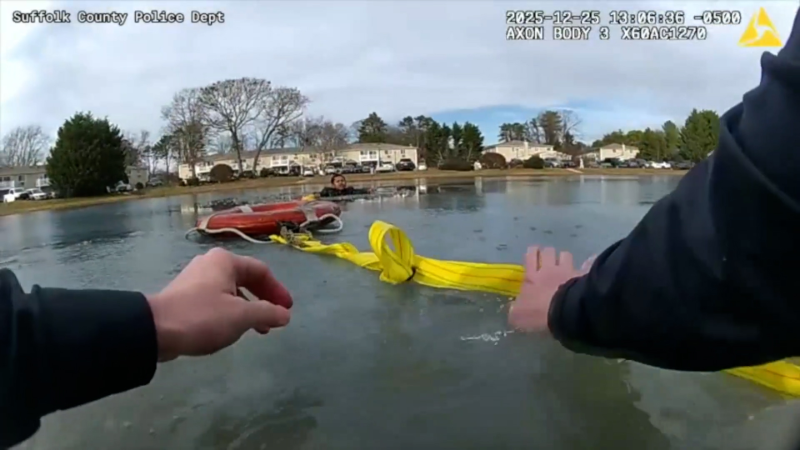Flash flooding kills 6 in North Carolina after days of heavy rain
At least 6 people have died and dozens were rescued as Tropical Storm Chantal drenched North Carolina with over 12 inches of rain.
Heavy rainfall and flash flooding inundated the city of Durham, North Carolina, on July 9. Water was seen gushing out of several manholes, and multiple abandoned vehicles were seen submerged.
North Carolina communities are still recovering after Tropical Storm Chantal brought days of torrential rain, flash flooding and deadly consequences to the state this week. At least six people have died as a result of the storm, which made landfall Sunday morning near Litchfield Beach, South Carolina, before tracking inland across the Carolinas.
Nearly 12 inches of rain fell in parts of the Raleigh-Durham area within a 24-hour period, with other locations reporting between 8 and 10 inches. The National Weather Service reported rainfall totals 200 to 600 percent above normal for central North Carolina, with the areas around Raleigh, Greensboro and Fayetteville hit especially hard.

Chantal’s impact was widespread. Three people were killed in Chatham County, North Carolina, including an 83-year-old woman whose vehicle was swept away and two boaters who drowned on Jordan Lake. In Orange County, 58-year-old Monica Butner died after her car became stranded in floodwaters while driving to work in Hillsborough. First responders found her body the next day, obscured by debris roughly 120 yards from her vehicle.
In Alamance County, a 23-year-old woman and a 71-year-old man were both found dead after being reported missing during flooding events. “The devastating power of stormwater caused Ms. Butner’s tragic death, despite the heroic efforts of searchers and the work of the top-notch professionals at Emergency Management,” Orange County Sheriff Charles Blackwood said in a statement.
This aerial video shows widespread flooding overtaking parks, roads, homes and businesses in Durham, North Carolina, on July 7. Several motorists were also seen stranded in the floodwaters.
Rescue efforts spanned multiple counties. In High Point, fire crews rescued roughly two dozen people from water-related emergencies between Wednesday night and Thursday morning, according to WXII12. Flood warnings were extended for the Haw River in Alamance County and Abbott’s Creek in Davidson County, with river levels exceeding flood stage on Thursday.

First named Tropical Storm Chantal brings devastation and flooding to central North Carolina and the Chapel Hill area in Chapel Hill, North Carolina, United States on July 7, 2025. (Photo by Peter Zay/Anadolu via Getty Images)

A view of destruction on a road to Chatham Central High School following the tropical storm Chantal in Bear Creek North Carolina, United States on July 8, 2025. (Photo by Peter Zay/Anadolu via Getty Images)

First named Tropical Storm Chantal brings devastation and flooding to central North Carolina and the Chapel Hill area in Chapel Hill, North Carolina, United States on July 7, 2025. (Photo by Peter Zay/Anadolu via Getty Images)
The city of Mebane, North Carolina, experienced extensive infrastructure issues after flooding damaged the Graham-Mebane Water Treatment Plant. Strict water usage restrictions were enacted as officials worked to restore service, according to WXII. As of Thursday, residents were told to reduce water use by 40 percent, and businesses were operating at 60 percent capacity. Water distribution efforts began shortly after the storm, with volunteers and local businesses like Foothills Brewing in Winston-Salem collecting and delivering drinking water to affected households. Boil notices in other cities, like Hillsborough, have been lifted although residents are still being urged to conserve water.
"Testing of water samples found no bacteria in the system. However, customers are urged to continue to conserve water to maintain water supply in the system because the Water Treatment Plant is offline," said a statement posted on the town's website.
Tropical Storm Chantal was the third named storm of the 2025 Atlantic hurricane season, following Andrea and Barry. AccuWeather meteorologists first designated the system a tropical rainstorm on Friday, July 4, to raise public awareness, before it was officially upgraded to a tropical storm on Saturday. “This was a classic example of homegrown development, by which a tropical storm formed close to the Southeast Atlantic coast and in an area where it is typical for July,” said AccuWeather Lead Hurricane Expert Alex DaSilva.

According to a preliminary estimate from AccuWeather, Tropical Storm Chantal caused between $4 billion and $6 billion in total damage and economic loss across the Carolinas. The figure includes damage to homes and businesses, lost tourism revenue, infrastructure failure, supply chain disruptions and financial losses from power outages and travel delays. “Chantal is yet another reminder that tropical storms that spin up quickly near the coastline can cause dangerous coastal and inland flooding,” said AccuWeather Chief Meteorologist Jonathan Porter. “This storm made landfall in the middle of the busy Independence Day weekend, disrupting holiday travel plans and creating dangerous beach conditions for thousands of families along the East Coast.” Infrastructure damage included more than 100 flood-related road closures and the collapse of State Highway 902 in Chatham County, where several swift-water rescues and fatalities were reported
Although the worst of the rainfall is now over, recovery efforts will be complicated by the heat. Forecasters say AccuWeather RealFeel® Temperatures could reach the upper 90s and low 100s through the weekend, increasing the risk of heat-related illness for outdoor crews and displaced residents.
Officials continue to urge caution around flooded roads, fallen power lines and debris-covered waterways. Several North Carolina state parks remained closed Thursday due to storm damage.
Report a Typo














